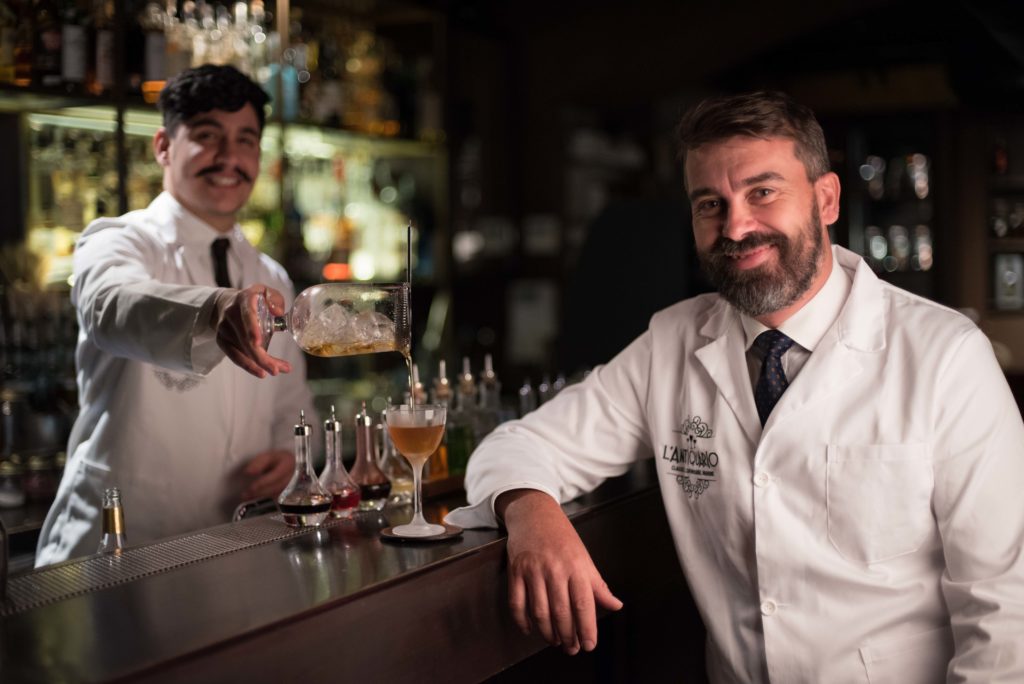[:it]Alex Frezza tells us all the secrets of Gin[:]

[:it]by ELISABETTA LUGLI
When you venture into the history of a great distillate you never find yourself faced with a simple preparation procedure, a dry passage between stills and barrels. What we find is something broader, a story that is linked to the past touching culture, society, historical events, religion: all the main areas of human affairs. And it is thanks to this that the story becomes truly fascinating.
In this sense, gin is no exception, on the contrary: it is perhaps among all spirits the one that is best able to reveal to us a history that is not only complex and ancient, but also broad, because unlike other spirits it has been produced almost everywhere .
We talked about it with Alex Frezza, who knows these things very well. Owner since 2007 together with three partners of Bar in Movimento, a cocktail catering company based in Naples, he has been involved in consultancy and training for clubs and companies for years. He is also the owner of two of the most beautiful clubs in Naples: L'Antiquario and Platanos.
Here's what he told us about gin.
Alex, tell us the history of Gin: what are the origins?
The history of gin is the history of juniper. We have to go back many years. Already in ancient China we find alcoholic infusions based on juniper, as well as in ancient Greece and the Middle East. In all these places, the infusion of alcohol and juniper always begins first as a cure, and then becomes a pleasure: gin has always been a distillate that has its best foot in the mix! Consider that even in Salerno, in the ancient Medical School, the monks created a sort of gin in their botanical garden, also with healing purposes. The journey of juniper combined with alcohol is truly an ancient and "transversal" journey.
In the modern era, where and when does gin appear in Europe?
In Holland, in the seventeenth century. At that time it was the perfect country for the spread of gin: there was a new type of bourgeoisie that had the possibility of emancipating and enriching itself, a liberal policy, the presence of the East India Company. Even in art you can notice this Dutch vocation: take the paintings of their great painters of the time, they are often rooms illuminated by a window through which sunlight passes. Inside the room, scenes of daily life usually take place. There is almost always a table with something to drink on it!
How does the story of gin continue?
From Holland, gin arrived in England. The massive diffusion occurred when William of Orange, a Dutch nobleman, ascended the throne of England by marrying Mary II Stuart in 1689. Obviously he brought the genever with him! Shortly afterwards he banned the importation of foreign spirits (it was a time of conflict between England and France, and the import block affected the spread of cognac in England, ed.). From then on, the Crown's grain surpluses were used to distill gin. Many distilleries were born. Gin began to cost less than beer and the population began to use it excessively.
What happened next?
There was a sort of war with the beer lobby. Just look at the famous print showing Gin Lane as a place of perdition and ruin and Beer Street as an idyllic place where people are happy. Then in the eighteenth century there were the Gin Acts, real restrictive laws, a kind of prohibitionism. Gin cost more again. The social situation improved and the first places used for consumption, the public houses, were also born. Later, at the beginning of the nineteenth century, the first Gin Palaces were born, precursors of today's bars. There the gin differs. It was consumed with cordials, or with ginger biscuits: if we think of today's Moscow Mule, we understand that the combination of gin and ginger comes from afar! Old Tom was also drunk, a sweeter gin, prepared with various spices, for example liquorice.
How does gin differ today?
Today there are three types. Normal gin is prepared by infusing botanicals in alcohol, then filtered. Distilled Gin instead sees the distillation of the botanicals, which is done separately; Flavorings can then be added. Finally the London Dry, which is the most complicated because all the botanicals must be distilled together and then only alcohol and water can be added. Taste, therefore, cannot be corrected with subsequent interventions.
What are the considerations you can make about gin nowadays?
After a long competition with vodka, today gin has broken even: they are the two most popular spirits. Gin remains an ever-evolving category, there is always the presence of juniper but the other botanicals present in every gin make the difference, all types are produced.
Can you leave us the recipe for a gin-based cocktail?
Certainly, a very simple one, that of French 75. My version is a little different from the official one, I prepare it with different quantities.
Here is the recipe:
5 cl of gin
3 cl of lemon juice
2 cl of sugar syrup
6 cl of champagne
It's not difficult to make at home too, you can have fun preparing it too!
[:]
